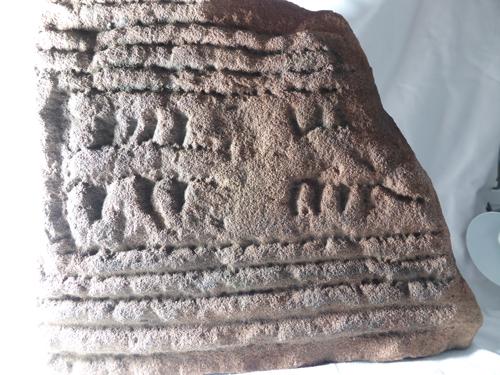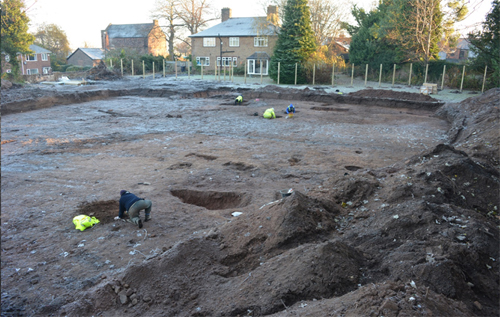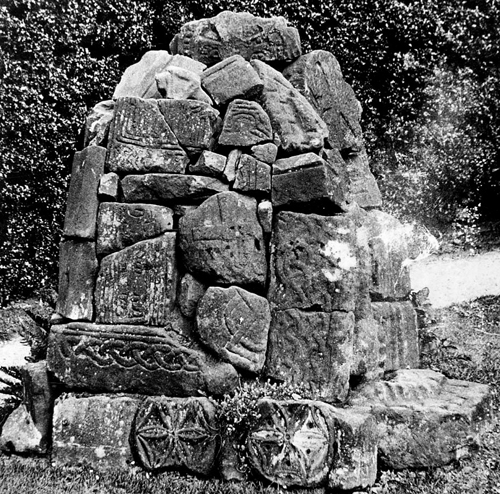Astonishing Anglo-Saxon artefact!

This rare and exciting fragment of Anglo-Saxon sculpture was found on an archaeological excavation at Mark Rake, Bromborough, Wirral in late 2016! The carved sandstone fragment is part of a slab carved between 900 and 1100 AD, and is decorated with incised lines marking out a border around what is probably a cross.
The site where it was found lies in the middle of Bromborough village, just to the north of the parish church which is dedicated to St Barnabas, and until recently the plot of land formed part of the Rectory gardens. The site came to the attention of Museum of Liverpool’s archaeologists when a planning application was made to build houses on the site after it was sold by the church.
Little is known of the origins of villages on the Wirral, but there are hints that many of them have been occupied since at least the Roman period and possibly longer; earlier excavations at Thorstone Drive, Irby and Hilary Breck, Wallasey, had found evidence for Prehistoric, Roman and early medieval buildings and other features and Mark Rake’s location, immediately next door to a church mentioned in the Domesday Survey, suggested that it had the potential for similar finds.
The site had also been test-pitted by members of the local community as part of the ‘Discovering Bromborough’ project run by Big Heritage. Although small in size (less than 1 m x 1 m) the test-pits had found small pieces of Roman pottery and other finds which further suggested that the site was worth excavating.
Another exciting and slightly unusual indication of the site’s potential was a large collection of Anglo-Saxon sculpture found in St Barnabas’ churchyard during the 19th century. The carvings were found when the church, built in 1828 to replace the earlier medieval building, was demolished in 1863 - they had apparently been used in the foundations of the 1828 church.
The carvings were then placed in a pile on the Rectory gardens (see photo below) where they stayed until 1909 when they were spread around the gardens in walls and rockeries. The Rectory was demolished and rebuilt in 1933 and it was at this point that most of the carvings disappeared despite a campaign by the Bromborough Society to save them. What actually happened is unclear but the builder at the time claimed not to have seen any carvings, though local rumour claimed that they’d been ground up to make sand!

The recent excavation had two aims, firstly to find evidence for early settlement on the site and secondly to find any of the lost carvings which might have survived the 1930s builder. The first aim was satisfied relatively quickly when ditches and pits were found at the southern end of the site. Although it was soon suspected that they were old, their exact date wasn’t clear until small pieces of Prehistoric pottery dating to about 1600-4000 BC were found in the soil they contained.
This part of the site’s story is still being studied but it looks as though the ditches marked out an enclosure or compound, possibly similar in size and shape to St Barnabas’ churchyard. At the moment it’s not possible to be certain what the enclosure was used for; was it a settlement or did it perform some sort of ritual or other special function? Unfortunately if it was a settlement any buildings would probably have sat where the churchyard is now and any remains will have been thoroughly destroyed by grave digging, so it’s likely that we will never know.
However, at the very least these finds prove that at least some Wirral villages are likely to have much earlier origins than we thought. It’s unlikely that any have been occupied continuously since 4000 BC, but there is now the likelihood that the same sites have been repeatedly reoccupied on many occasions since humans began to permanently occupy Merseyside.
The Anglo-Saxon sculpture took a little longer to find. The first place we looked was the wall which formed the northern boundary to the garden. Part of this had to be dismantled so that the builder could get tools and equipment on to site and this was done stone by stone so that we had the best chance of finding any carvings which had found their way into it. It soon became clear that the wall had probably been built within the last 40 years, long after the carvings were lost, and that there was little chance of finding any within it. However, every piece of sandstone was checked as it came out, though the oldest piece was a lintel from a 19th century bathhouse re-used to build the wall.
The next stage of the search was to dig out the topsoil across the building site. The area covered was so big that this had to be done with a digger, but very carefully; no more than 5-10 cm deep at a time. This process took about 10 days in total and after about 8 days of turning over every piece of sandstone on the site I’d just about given up hope of finding any carvings. It was the builder’s digger driver, Ritchie, who pointed me towards a block of sandstone about 30 cm across which he’d tipped out of the digger bucket for me to check. As I walked towards it I didn’t hold out much hope, this was one of several hundred pieces of sandstone I’d checked and from a distance it looked blank. A close look suggested that this was another false alarm; the surface I could see was just like all the others, blank of any carving, but I turned it over to check the other side anyway.

The carving was taken back to our offices the same day, carefully washed and examined. A quick check of a photograph of the carvings taken in the 1880s soon confirmed that the find was one of those stacked on the lawn and that it was probably part of a group with similar decoration. I’ve found hundreds (possibly thousands) of interesting artefacts in the years I’ve worked in archaeology, but this one must make it into the top ten.
At first I wasn’t sure what I was seeing, the stone’s face was covered in wet soil, but a very careful brush with my fingers confirmed that shallow grooves in the stone’s face were man-made and that we’d found at least one of the lost carvings. Work with the digger then went much more slowly in the hope that more carvings would be found but all that was there in the area where the carving was found was a thin layer of red sand and cobbles; it looks like the local story about the builder in 1933 having smashed them up was true and that we’d found the only survivor.
I’d like to thank Nic Phipps of Harry Phipps & Co who kindly sponsored the excavation and donated the finds to Museum of Liverpool. Also Ritchie of Richard Rogers Excavations for spotting the carving after my eyes had possibly started to glaze over!
Finds from the excavation at Bromborough were displayed as part of our Festival of Archaeology.
